22 Merle Dog Breeds & What Makes Them A Merle Dog
May 16, 2021 2023-05-17 12:04What is a Merle Dog?
A merle dog is a dog with a unique coat pattern that is created by the presence of the “merle” gene. This gene causes the pigment in the coat to be unevenly distributed, resulting in patches of diluted color on a solid background. Merle dogs can have a wide range of coat colors, including blue, red, chocolate, and fawn. The merle dog color pattern itself can also vary in intensity, with some dogs having a subtle speckling effect and others having a more pronounced marbled appearance.
Here are 22 breeds that can show merle patterns:
Table of Contents
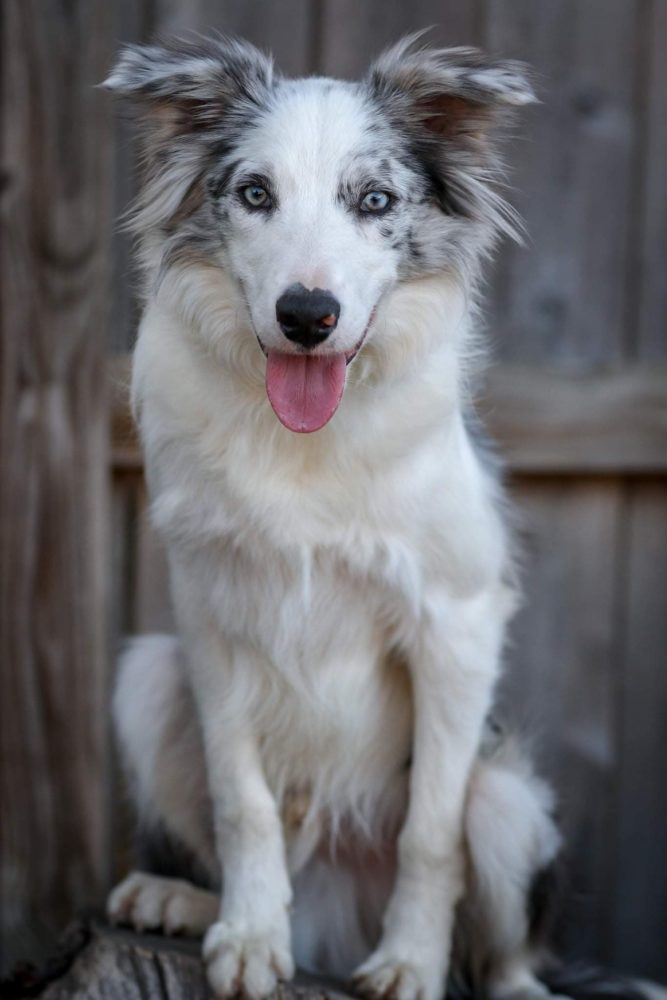
22 Merle Dog Breeds
Here are our favorite merle dog breeds:
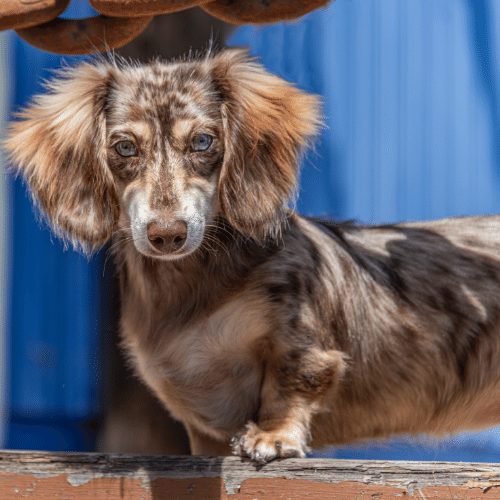
1. Dapple Dachshund
Merle Dachshunds are called “dapple”. The merle gene is quite rare among Dachshunds, and not seen too often. It can appear in all three coat varieties: long, short and wire-haired. The AKC breed standard specifically states that merle is an allowed coloring. The smaller and more even the spots are, the higher these dogs score in conformation shows.
Like in all breeds with the merle pattern, these dogs often have eyes with different colors or can have two colors in the same eye. The dapple pattern does not affect the dog’s vision or temperament – it just makes your Dachshund look extra special!
Dapple Dachshunds have become increasingly popular in the last decade, and that is reflected in their price. Be prepared to pay upwards of $1,500 for a dapple Dachshund puppy.
2. Australian Shepherd
Australian Shepherd are one of the most common breeds showing the merle pattern. Roughly 40% of all Aussies are merle – most breeders pair a merle and a non-merle dog, and the resulting litter will statistically have ½ merle-patterned dogs and ½ regular colored dogs.
Most Australian Shepherds are tri-colored, meaning that they have tan points (brown checks, eyebrows and markings on their legs). These tan points are also prominent in the merle pattern – merle does not affect tan points, only the base color of the dog.
Most merle Australian Shepherds are blue merles or red merles with said tan points. Bi-colored dogs with a merle pattern are much more rare.
While most Australian Shepherds also like to cuddle, they are high-strung working dogs and require daily mental and physical exercise. These are not dogs for owners who most like to relax at home!
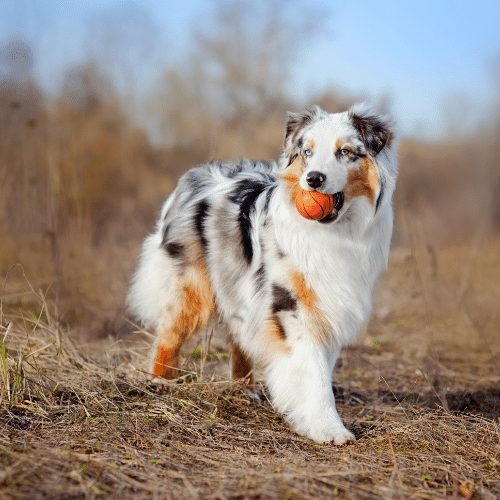

3. Cardigan Welsh Corgi
While Corgis are not commonly seen with a merle pattern, the AKC breed standard specifically allows merle colored Cardigan Welsh Corgis. These are most commonly blue merle (appearing greyish) or blue tri merles (the same grey, but with tan points). Light-grey and blue eyes are very common in merle Corgis.
Cardigan Welsh Corgis can be distinguished from their cousins, the Pembroke Corgis, by the tail: while Pembrokes have a docked tail, Cardigan Corgis have an intact tail. Additionally, merle is not an allowed pattern for Pembroke Corgis, though some breeders have outcrossed these dogs in order and produced mixes of both Corgi breeds.
In the last decade, the Miniature Corgi – an especially small version of the regular-sized Corgi – has become increasingly popular.
4. Pyrenean Shepherd
The Pyrenean Shepherd is a small herding dog originating in the French Alps. While common in Europe, very few of these dogs exist in North America these days. There are two distinct varieties: the poil long (with long, scruffy-looking hair across the whole body) and the face rase (with slightly shorter hair and a smooth coated face). PyrSheps can have a number of different colors such as black, fawn and grey with a black mask. The merle pattern can occur in combination with all of those, though it is most commonly seen in blue merle dogs.
Pyrenean Shepherds have very little white on their body compared to some of the other dogs in this list. Ideally, dogs should have little to no white at all, even on their chest.
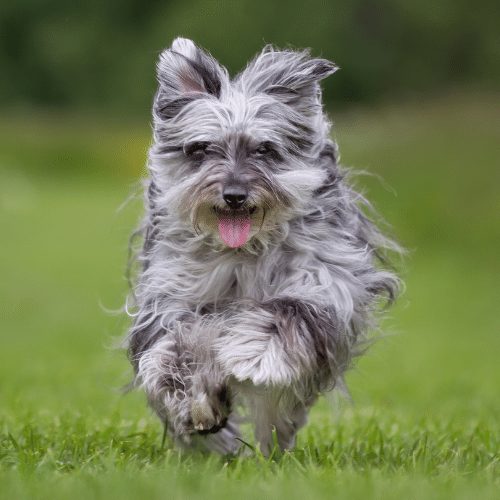
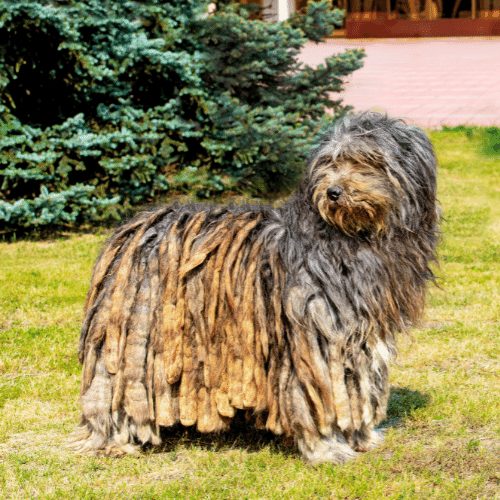
5. Bergamasco Shepherd
The Bergamasco Shepherd is a herding dog from Italy. The most striking feature is his extremely long and thick coat that forms natural dreadlocks and grows all the way to the ground. By the time a dog is around 5 years old, the dreadlocks reach down to the floor. While impractical for many owners nowadays, this coat once made the Bergamasco Shepherd an extremely hardy sheepdog which could withstand strong winds, heavy rains and cold temperatures.
The Bergamasco can be any shade of grey/black or fawn, with or without the merle pattern. In dogs with a heavy coat, it can be difficult to pinpoint the exact color.
6. Catahoula Leopard Dog
The Catahoula Leopard Dog is a very unique looking dog from Louisiana. This dog originally was used for hunting feral pigs. Strong-willed and athletic, the breed is appreciated for its temperament and work ethic as much as for its looks.
Catahoulas can have a wide range of colors and show spotting of different forms and hues, ranging from cream-colored all the way to solid black. All colors can occur with or without the merle pattern.
Some owners decide on a Catahoula based on the unique coloring alone. Do not make this mistake! These dogs are highly athletic and require intense exercise as well as a knowledgeable trainer. They are not the right choice for first-time dog owners. Unless you are willing to spend at least 2 hours every day working with your Catahoula, decide on a different merle-colored breed with less extensive activity needs.
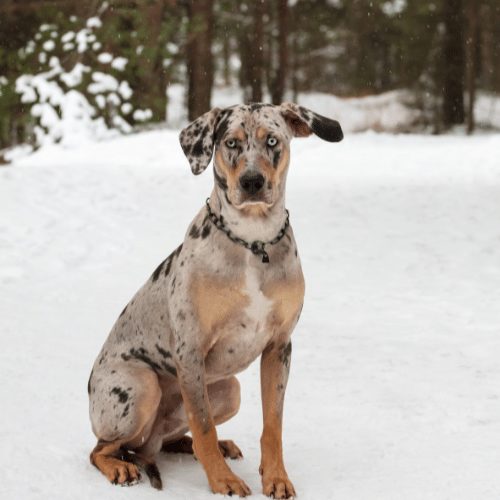
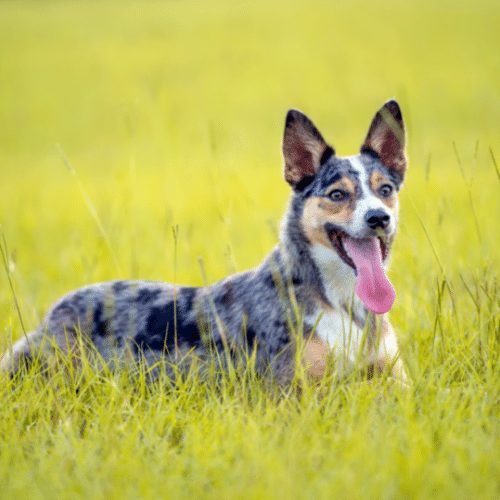
7. Koolie
The Koolie is another merle-patterned breed with very high exercise needs. If you have never heard of the Koolie before, you can think of this breed to be a cousin to the Border Collie. With a similar size and build, these dogs are very athletic herders originating in Australia.
Koolies are medium-sized dogs that are about 18-22 inches in height. They have large, erect ears and are usually short-coated (though there are a few long-coated Koolies as well). Their typical colors are red and black – and both of these can occur in combination with the merle gene as well.
Koolies have become increasingly popular in the US in the last decade for their athleticism and work ethic. Many owners who pursue competitive dog disc sports (essentially frisbee routines that get scored) opt to import or domestically breed these dogs. Once more, Koolies are a breed with high exercise and training requirements – you should never decide for a Koolie based on the color alone. Only commit to this breed if you are ready to fulfill the activity needs that come with it.
8. Sheltie
Shelties are popular family and sport dogs. Once bred to herd, these extremely intelligent and fast dogs excel at a range of dog sports these days. Whether agility, obedience or barn hunt, they love to learn new skills and work together with their owner.
Shelties most often are sable-colored, but can also be tri-colored or bi-black. The merle pattern can occur in combination with any of these colors: blue merle, blue merle tri or sable merle are allowed by the breed standard.
While European Shelties have a manageable coat, many US lines of Shelties have an extremely dense and long coat. First-time Sheltie owners can be surprised and overwhelmed by the amount of grooming that’s required to keep it clean and free of tangles.
Before deciding for a merle Sheltie, make sure you are up for the grooming needs of this breed!
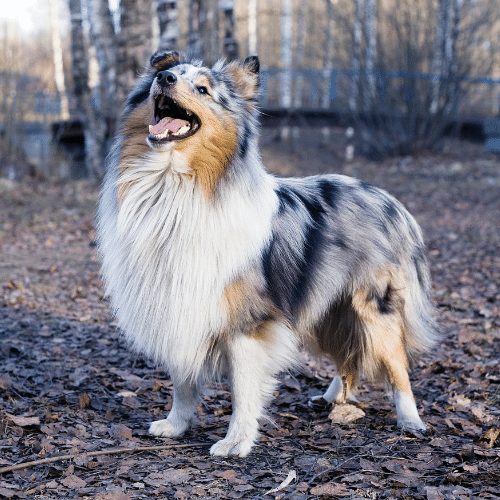
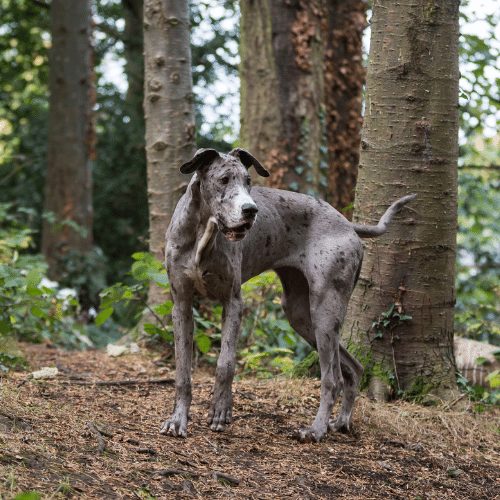
9. Great Danes
Great Danes are best known for fawn or harlequin coloring, but they can come in the merle pattern as well. A lot of blue merle Great Danes have minimal white – their merle pattern spreads across the whole body without white patches on the head, neck, chest or feet.
While show dogs usually have their tails docked and their ears cropped, Great Danes look just as beautiful with ears and tails intact.
Unfortunately, Great Danes are not the healthiest breed. In order to ensure a long and healthy life for your Great Dane, you always need to make sure to purchase a puppy from a responsible breeder and health-tested parents. Color should be secondary in this choice!
On the topic of health – you absolutely want to avoid getting a double merle Great Dane, as these merle pups are quite unhealthy.
10. Border Collie
Border Collies are known to only be black and white. This is quite far from the truth! This breed in fact can have a large number of different colors, ranging from common ones like red and white to extremely exotic and rare colors such as lilac merles with tan points.
Merle Border Collies are often confused with merle Australian Shepherds. In order to tell them apart, look for the following features:
- Ears: Australian Shepherds have floppy ears, while a Border Collie’s ears are tipped or erect
- Coat: Aussies have a thick coat without long furnishings. Border Collies’ coat is thinner but has longer hairs at the back of the legs, underneath the belly and on the hindquarters.
- Tail: In some countries (like the US), Aussies’ tails are docked. Border Collies tails are always left intact.
(If you are interested in an in-depth comparison, check out our Australian Shepherd vs Border Collies article!)


11. Rough Collie
A cousin to the Border Collie, the rough Collie looks like a big brother of the Sheltie. The most common color in Rough Collies is sable, followed by black tri. The merle pattern is seen more often these days than a few decades ago, because of the popularity of this coloring.
Rough Collies have large amounts of white on their chests and necks. A typical merle Rough Collie will have the merle pattern across his rump and on his head, with a wide white collar and white blaze on his head.
Rough Collies are great family and companion dogs. They are very friendly and generally easy to train. The biggest challenge with these dogs is keeping up with their grooming needs – daily brushing is a must with a Rough Collie. If this sounds too much, you can consider the short-coated variety of the Collie, the Smooth Collie:
12. Smooth Collie
The Smooth Collie essentially looks identical to the Rough Collie, but he has short hair all across his body. This breed is a lot less common than the Rough Collie, and in fact often gets mistaken for a shaved Rough Collie!
Smooth Collies’ coat care is very low-maintenance and easy. For first-time dog owners, these are the perfect Collie breed. Smooth Collies also mainly come in sable and black tri. The merle pattern is seen in combination with black tri, and the resulting dogs are blue merle tri.
If you have your heart set on a merle Collie, chances are you will have an easier time finding a merle Smooth Collie puppy than a rough Collie.
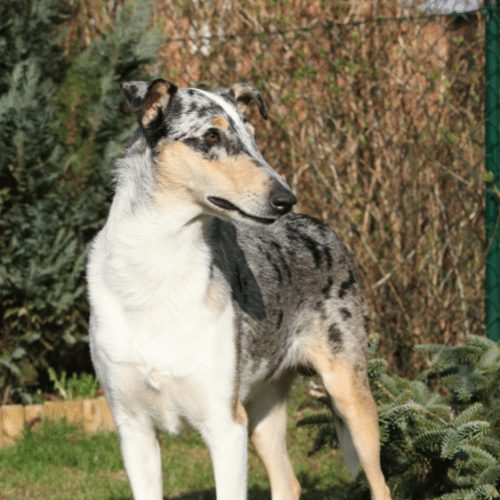
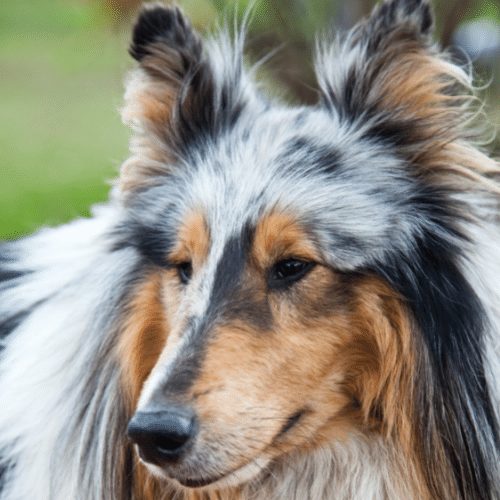
13. Scottish Collie
The Scottish Collie is a very old breed which is one of the forefathers of many of today’s herding breeds. It originated (of course) in Scotland.
In recent years, a movement started in the US to bring back the original Scottish Collie. Breeders are crossing Smooth Collies to other herding dogs such as Border Collies, English Shepherds and German Shepherds to create an agile, intelligent and brave working dog.
The Scottish Collie can have a wide range of allowed colors, including bi black, black tri, sable, blue merle, blue merle tri and others.
The American Kennel Club currently does not accept the Scottish Collie as a registered breed. The breeders of Scottish Collies breed under their own association and breeding registry.
14. Chihuahua
Merle Chihuahuas are dogs in high demand (and their price reflects this). They are one of the few small merle breeds (most merle dogs are medium to large breeds). Chihuahuas can have a wide range of different colors, including white, brown, red, black, brindle and sable – and these can occur with or without merle patterning.
The AKC currently does not allow merle Chihuahuas to be registered, as they usually are a result of crossbreeding.
Chihuahuas come in two different coat varieties: smooth and rough (that means short and long hair). The merle pattern can occur in both coat options.
If you decide for a merle Chihuahua, be sure to not make the mistake to think that this little lap dog doesn’t require training and exercise. Many small breed dogs develop severe behavioral issues such as separation anxiety or reactivity due to the owners not investing enough time and energy into training. Your Chihuahua needs you to treat him like a big dog when it comes to teaching him how to behave well.


15. Bulldogs
Bully breeds of any kind are popular dogs all across the US. In other countries, breed legislation has made it harder to breed and purchase/adopt this breed.
Bully breeds come in pretty much any color you can think of, including white, black, parti-colored, brindle, fawn, cream, red, gold, brown, grey, blue – and also with the merle pattern!
While merle was not originally part of the breed and was added through outcrosses. This is also the reason that the AKC currently does not allow merle Bully breeds (such as Pitbulls) to be registered as pure-bred dogs.
However, if you are looking for a cool companion dog, it doesn’t really matter if you can register your pup or not – and a merle Bulldog is sure to turn some heads when you guys go for walks together!
16. Beauceron
The Beauceron is a yet another herding dog from the French Alps. While very popular in France, this breed is relatively unknown in the US, and it is in fact very difficult for most puppy buyers to find a Beauceron breeder nearby.
Beaucerons are large dogs, weighing as much as 100 pounds for heavy males.
Nowadays this dog is not used much anymore for herding, but as a guard and companion dog and also in the sport of protection (IPO and French Ring). They also work as search and rescue dogs.
The Beauceron mostly has a black and tan coloring. However, the breed standard allows for merle-patterned dogs as well. The breed has very little to no white, whether in the solid-colored varieties or in the merle-patterned one. The two dogs in the picture are a solid black and tan mother and her blue merle tri offspring.
In the US, Beaucerons have their ears cropped and tail docked. In Europe this practice is outlaws – you will only see this breed with a natural tail and floppy ears there.

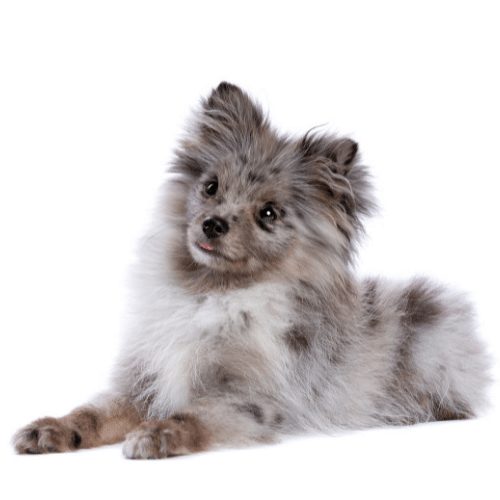
17. Pomeranian
The Pomeranian is a very popular toy dog breed. This breed comes from Nordic countries and is a descendent of the “Spitz” dog type.
These dogs have a dense coat, prick ears and very pointy nose. Pomeranians most often are seen in the colors of solid white or orange/red. The merle coloring is rather rare and if you are looking for such a dog, you are likely to spend quite a bit of time (and money!) to get your puppy.
Pomeranians have a docile temperament and love all people and dogs. They are easy to train and do not have a high prey drive. The most common training struggles owners experience are potty training problems as well as separation anxiety. It is important to get your Pomeranian puppy (whether a merle-colored one or not) used to staying by himself early on to avoid future training struggles.
18. Poodle
Poodles come in three sizes (Toy Poodles, Miniature Poodles and Standard Poodles) and can have many different colors – from solid-colored to parti-colored.
While the American Kennel Club currently does not accept merle-patterned dogs, some Poodle breeders have been crossing other breeds into their lines to produce merle Poodles.
Poodles are great family and companion dogs – they are usually easy to train, unlikely to show reactivity or aggression and friendly with people and dogs.
One problem many Poodle owners face is their sensitive digestion – some Poodles suffer from recurring bouts of diarrhea with no apparent cause or cure. If you decide on a merle Poodle, be prepared to feed him a careful diet and manage his sensitive stomach throughout his life.
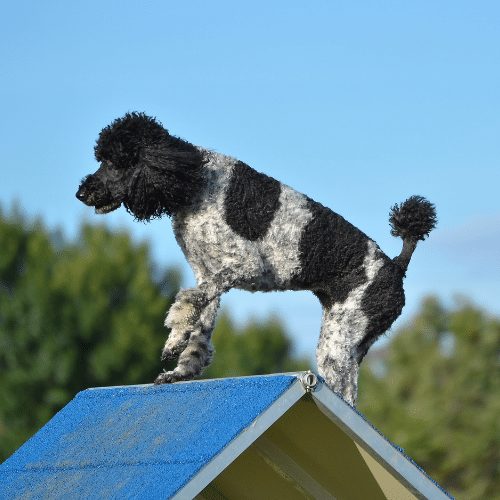
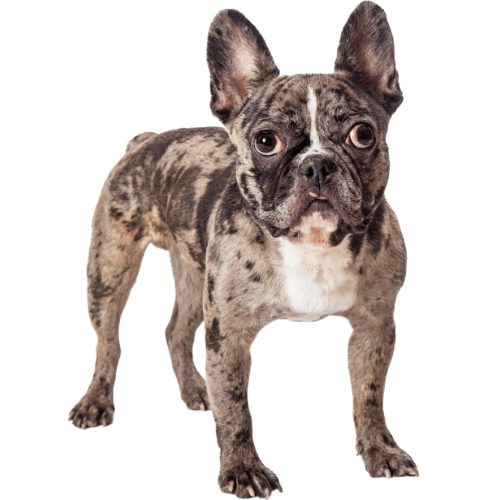
19. French Bulldogs
French Bulldogs are an extremely popular breed – they ranked #2 in the US in 2020. Small, feisty and always up for fun, it is easy to see why they are so popular!
Most French Bulldogs are brindle and white or fawn, but they can come in many other colors, such as cream, blue, black – or with a merle pattern!
Merle French Bulldogs are currently not allowed to be registered with the AKC, as the merle pattern does not naturally occur in this breed – it was most likely introduced through outcrosses with merle Chihuahuas.
However, if you are searching for a good-looking pet and do not mind not being able to register your pup, a merle French Bulldog is a great choice.
French Bulldogs in general are rather expensive dogs and a merle-colored pup might be even pricer with up to $3,000. They are some of the most costly merle dogs you can find. The novel and unique Fluffy Frenchie will be even more expensive.
20. Mudi
Like the Pyrenean Shepherd, the Mudi is a small herding breed from Europe that is not very well-known outside of his home country. In fact, at the time of this writing the AKC does not yet recognize the Mudi as a breed of the herding group. Mudis have been registered in the Foundation Stock Service Program (FSS) so far. Starting January 2022, they will be acknowledged as a herding breed under the regular herding group.
Mudis are small, energetic and vocal dogs. They love to bark and run. Mudis can have different colors, such as cream, brown or black. The most common merle patterns in the breed appear in black and brown dogs – which are blue merle and red merle.
Mudis are a challenging breed that is not suitable for first-time dog owners. They can be very high-strung and often exhibit behavioral issues such as nervousness, fearfulness or separation anxiety.
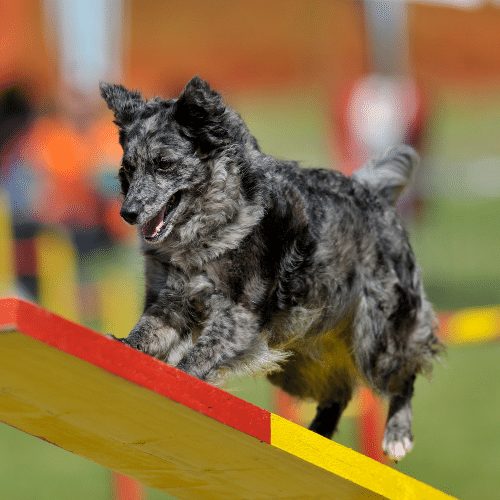
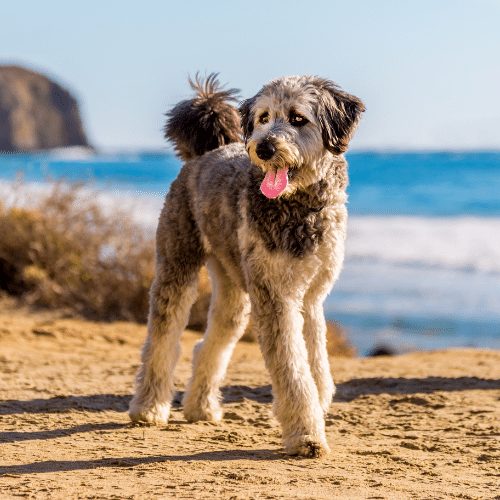
21. Aussiedoodle
Aussiedoodles are a popular Doodle cross – they are the result of pairing Poodles with Australian Shepherds. The resulting dogs can come in a range of colors and sizes. If a Mini Aussie and a Toy Poodle are crossed, the offspring are Mini Aussiedoodles and can be as small as just 10 inches tall, Crossing a Standard Poodle with a large Australian Shepherds produces tall and strong offspring that can be as heavy as 55 pounds.
Because crossing these two breeds combines the color and pattern variations of both the Poodle and the Australian Shepherd, the possible color combinations of the puppies are endless.
From all-white over cream and apricot-colored to tri black, grey, parti-colored and of course merle, you can pick your favorite color among many choices! The merle gene is introduced into this cross from the Australian Shepherd parent. If one parent is merle-patterned, statistically 50% of the offspring will carry the merle gene and show this coloring. In reality, statistics do not always play out perfectly of course – you could have an entire litter of merle-patterned puppies, or none at all.
If a parent carries merle, he will look merle. This also means that if you cross a solid colored Poodle and a non-merle Aussie, it is guaranteed that none of the offspring will have the merle coloring.
22. Mini Aussie
The last dog in our list is the miniature version of the Australian Shepherd.
A decade ago, Miniature Australian Shepherds were simply “small Aussies”. These days though they are recognized as a separate breed and also referred to as “Miniature American Shepherd”.
Mini Aussies are very popular companion and family dogs. They are not only pretty lap dogs though – this breed excels at agility, rally, barn hunt and disc dog competitions as well!
Mini Aussies can have the same colors as their larger cousins: Black and tan, red and tan, and merle versions of both of these. Bi-colored Mini Aussies (without tan points) are very rare, though they do exist.
Many future owners of Mini Aussies have their heart set on getting a merle-colored puppy. Remember that every litter statistically only produces 50% merle-patterned dogs – that means that each breeding will produce solid-colored dogs as well. They are just as intelligent, loving and beautiful as the merle variety of the breed!
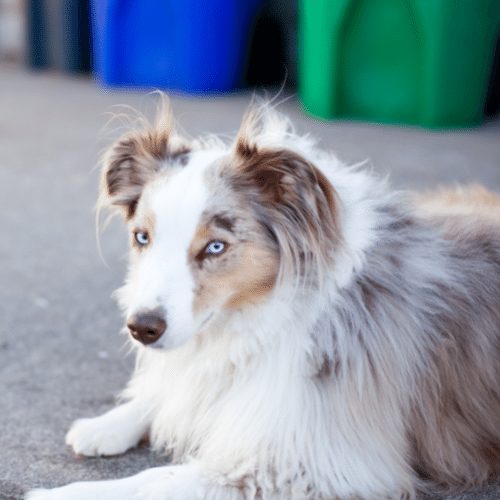
What is a Double Merle Dog
It’s important to note that breeding two merle dogs together can result in what is known as a “double merle” or “lethal white” dog. Double merle dogs have two copies of the merle gene, which can increase the risk of hearing and vision problems, including deafness and blindness. Responsible breeding practices, such as avoiding breeding two merle dogs together, can help to reduce the likelihood of producing double merle puppies and promote the health and well-being of merle dogs.
Merle Dog Genetics
The discovery of the merle allele is not attributed to any one individual or group, as it likely occurred through natural genetic variation and selective breeding practices over time. However, the Merle gene has been known and used by dog breeders for many years to produce dogs with unique and desirable coat patterns. The first records of merle dogs date back to the early 20th century, with the Australian Shepherd being one of the first breeds to be recognized for its merle coat pattern. Since then, the Merle gene has been identified in many other dog breeds and is now recognized as a common and distinct genetic trait in dogs.
Merle Dog Temperament
The temperament of merle dogs can vary depending on the breed and individual dog. However, in general, merle dogs are known to be highly intelligent, active, and trainable. Many merle breeds were initially developed for working purposes, such as herding or hunting, and as a result, they tend to be highly energetic and enjoy having a job to do.
Merle dogs can also be loyal and affectionate with their owners and are often good with children and other pets. However, as with all dogs, proper socialization and training are important to ensure that they develop good manners and behavior. Some merle dogs, especially those with strong herding instincts, may be prone to nipping or herding behavior if not properly trained and socialized.
It’s important to note that the temperament of a Merle dog should not be solely based on its coat pattern. Each dog, regardless of its coat color or pattern, is an individual with its own personality and needs. If you’re considering getting a merle dog, it’s important to research the breed and meet individual dogs to find one that suits your lifestyle and personality.
Merle Dogs and the AKC
The American Kennel Club (AKC) recognizes several dog breeds that can have a merle coat pattern. These breeds are:
Australian Shepherd
Border Collie
Catahoula Leopard Dog
Cardigan Welsh Corgi
Chihuahua (long coat)
Dachshund (longhaired)
Great Dane
Shetland Sheepdog
It’s important to note that not all dogs with a Merle coat pattern are recognized by the AKC and that some Merle breeds may be recognized by other breed clubs or organizations. Additionally, as previously mentioned, responsible breeding practices are essential to ensure the health and well-being of merle dogs, regardless of breed.

